 Passing
through Huntington, we learned that our best route would be up the tow-path of the canal,
which would have been excellent traveling , had it not been made almost impassable by a
recent rain. We found the county to consist of heavily timbered, low, level, wet land, and
was made more gloomy in appearance by the continuous rainfall in the afternoon. Passing
through Huntington, we learned that our best route would be up the tow-path of the canal,
which would have been excellent traveling , had it not been made almost impassable by a
recent rain. We found the county to consist of heavily timbered, low, level, wet land, and
was made more gloomy in appearance by the continuous rainfall in the afternoon.
History of Wabash County. 1884. p. 106

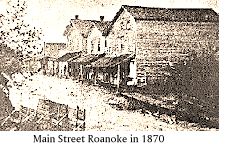 In 1853, a boat landed at the lock of the Wabash & Erie canal about 50 yards
southwest of the present interurban station in Roanoke. This boat came from Bethlaham,
Ohio. It took on a family consisting of a father, mother, one sister and two brothers, the
younger brother and the author of this sketch then being nine years old. In 1853, a boat landed at the lock of the Wabash & Erie canal about 50 yards
southwest of the present interurban station in Roanoke. This boat came from Bethlaham,
Ohio. It took on a family consisting of a father, mother, one sister and two brothers, the
younger brother and the author of this sketch then being nine years old.

The boat came by way of Cleveland, where all the goods were transported on
a like steamer for Toledo where another transfer was made. The steamer left Cleveland at
twilight and landed at Toledo at nearly dawn. In those days, and for a long time
thereafter all travel across the lake was dry by night--why this was so I never learned.
At Toledo our goods were transferred to a horse powered canal boat and we started on the
last leg of our journey and one week after embarkation at Bethlaham we landed at our
destination. Other parties of the family started on a heavy laden wagon and made the trip
in just the same time that our party did in spite of the more rapid transit across the
lake by steamer.

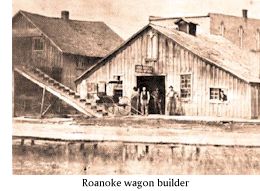 The condition of the country from Fort Wayne to
Roanoke was so incredibly stamped on my youthful mind that it can never be erased. The
beautiful farms, fields and homes that you now behold as you travel along the Little River
Valley was then a dismal swamp, consisting of black mire, stagnant water, old logs, trees,
mosquitoes, snakes, frogs and ague germs. I doubt if the swamps of the Nile can produce a
more God-forsaken and desolate stretch than was the Little River Valley, now scarcely more
than a creek, in those days and yet, it would seem that in the creation it was designed
that even this most despised portion of Indiana should donate their share of sustenance to
the hardy race of early pioneers. For here, wild geese, ducks and other water fowl swarmed
in innumerable flocks, the river swarmed with fish. The condition of the country from Fort Wayne to
Roanoke was so incredibly stamped on my youthful mind that it can never be erased. The
beautiful farms, fields and homes that you now behold as you travel along the Little River
Valley was then a dismal swamp, consisting of black mire, stagnant water, old logs, trees,
mosquitoes, snakes, frogs and ague germs. I doubt if the swamps of the Nile can produce a
more God-forsaken and desolate stretch than was the Little River Valley, now scarcely more
than a creek, in those days and yet, it would seem that in the creation it was designed
that even this most despised portion of Indiana should donate their share of sustenance to
the hardy race of early pioneers. For here, wild geese, ducks and other water fowl swarmed
in innumerable flocks, the river swarmed with fish.

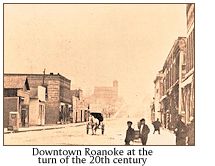 In building the canal, which
was done through our section during the years of 1834 to 1837, the survey was made near
the edge of the water and near high land. The dirt which was taken from the ditch with
shovel, pick and wheelbarrow was thrown on the water on the lower side, thus forming a
levee that held back the water and served as a towpath on which the horses traveled while
pulling the boats laden with goods destined for the inhabitants of the far west. These
boats were the only means by which our meager crops could be transported to eastern
markets and a great source of convenience it proved to be, although somewhat slow. When we
landed at Roanoke, or what was better known then as the "lock", we found a
thriving village of from one hundred to one hundred and fifty people. The town like the
city of Rome was situated midst its seven hills, all densely covered with a luxuriant
growth of mammoth forest trees-oak, ash, walnut, hickory, beech, elm and maple and various
other kinds, in the fruits of which the settlers were fully, as if more interested than in
their meager corn crops, for the fattening of their hogs depending largely on a bountiful
crop of the various varieties of nuts, the most important of which was the acorn and the
beech nut. In building the canal, which
was done through our section during the years of 1834 to 1837, the survey was made near
the edge of the water and near high land. The dirt which was taken from the ditch with
shovel, pick and wheelbarrow was thrown on the water on the lower side, thus forming a
levee that held back the water and served as a towpath on which the horses traveled while
pulling the boats laden with goods destined for the inhabitants of the far west. These
boats were the only means by which our meager crops could be transported to eastern
markets and a great source of convenience it proved to be, although somewhat slow. When we
landed at Roanoke, or what was better known then as the "lock", we found a
thriving village of from one hundred to one hundred and fifty people. The town like the
city of Rome was situated midst its seven hills, all densely covered with a luxuriant
growth of mammoth forest trees-oak, ash, walnut, hickory, beech, elm and maple and various
other kinds, in the fruits of which the settlers were fully, as if more interested than in
their meager corn crops, for the fattening of their hogs depending largely on a bountiful
crop of the various varieties of nuts, the most important of which was the acorn and the
beech nut.

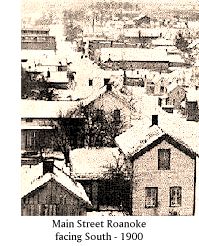 The town was inhabited by a sturdy
variety of families from the east who had emigrated westward to find cheaper lands and
homes. Many of whom we recall, Marten Bash and Aunt Katy who conducted a dry goods and
grocery store, Ruban Ebersole, the druggist at the locks who daily issued out quinine to
those afflicted with plague. At one time it was said that there were but two families in
town who did not have from one to many cases of the dread disease. Daniel Welsh had a
small grocery store on the east side of the lock. His consisted mostly of the boat crews
and Indians. T.V. and Frank Horton, who gave much of their time to land speculation and
later built a factory for manufacturing of all kinds of woolen goods and for the time
being did a thriving business. The town was inhabited by a sturdy
variety of families from the east who had emigrated westward to find cheaper lands and
homes. Many of whom we recall, Marten Bash and Aunt Katy who conducted a dry goods and
grocery store, Ruban Ebersole, the druggist at the locks who daily issued out quinine to
those afflicted with plague. At one time it was said that there were but two families in
town who did not have from one to many cases of the dread disease. Daniel Welsh had a
small grocery store on the east side of the lock. His consisted mostly of the boat crews
and Indians. T.V. and Frank Horton, who gave much of their time to land speculation and
later built a factory for manufacturing of all kinds of woolen goods and for the time
being did a thriving business.

Mr. Grim succeeded Mr. Minich as trustee of Jackson Township. Louis
Mellinger occupied a log cabin and was the town ax handle maker and coon hunter. William
Christy was a blacksmith and occupied the lot where the oil that at one time he invented a
supply station is located. Thomas Hackett, farmer, sawmill operator and first justice of
the peace of Jackson Township, live a short distance west of town, and later added a corn
grinder to his mill.

Mr. Eaton, grandfather of Gary Rose, was also a sawmill operator. He built
his mill near where LLoyd Waid's residence now stands, where he continued in business for
a number of years. Mr Viberg, a very eccentric character of German birth, who was
proprietor of the farm now owned by M.V. Richards, I think held a patent for the land
issued to him by the government.

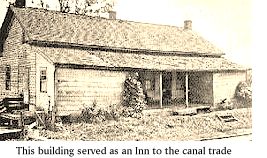 Mr. Rockwell, who lived on Posey Hill, had his
marvelous genius and skill as an artist. A sample of this may yet be seen in the IOOF
desk, and was also a genius at invention. It was said of him...flying machine and when
completed, took it to a high elevation, adjusted it to his body and leaped into the air,
but instead of soaring off into space as he hoped to, he came rather suddenly and abruptly
in contact with his mother earth below. His injuries were not serious and in explanation
of the failure he said the mishap was no fault of his invention, but that he had forgotten
to operate the machinery! Mr. Rockwell, who lived on Posey Hill, had his
marvelous genius and skill as an artist. A sample of this may yet be seen in the IOOF
desk, and was also a genius at invention. It was said of him...flying machine and when
completed, took it to a high elevation, adjusted it to his body and leaped into the air,
but instead of soaring off into space as he hoped to, he came rather suddenly and abruptly
in contact with his mother earth below. His injuries were not serious and in explanation
of the failure he said the mishap was no fault of his invention, but that he had forgotten
to operate the machinery!

Calep Eldrid, one of the good citizens and a maker of tinware, had a small
shop on the east side of Commercial street and made all kinds of tinware, as ready made
goods of this kind were not on the market. Later on he moved to Ligonier, a thriving town
in Noble county, here he embarked in the drug and soon became postmaster. Drs. Brown,
Hettler, and Health were the practicing physicians of the town and a wide circle of the
country around......
Roanoke History Dr. S. Koontz. Roanoke Review, 1921

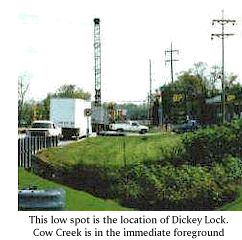
 Among the earliest comers to the place were a number of canal employees, and about
the year 1847 a man by the name of Bilby opened a small store in a little frame building
that stood near the lock on the east bank of the canal. Lemuel G. Jones in 1848, purchased
the building, and for about three years thereafter, carried on a fairly successful
mercantile business. His principal customers being those who ran boats on the canal. Prior
to engaging in merchandising, Mr. Jones erected a sawmill at the lock, and a couple of
years later, built a large flouring-mill on the same spot, which began operations in the
fall of 1848. The mill received its motive power from the waters of the canal, and for a
number of years was the largest and most successful enterprise of the kind in Huntington
County. Among the earliest comers to the place were a number of canal employees, and about
the year 1847 a man by the name of Bilby opened a small store in a little frame building
that stood near the lock on the east bank of the canal. Lemuel G. Jones in 1848, purchased
the building, and for about three years thereafter, carried on a fairly successful
mercantile business. His principal customers being those who ran boats on the canal. Prior
to engaging in merchandising, Mr. Jones erected a sawmill at the lock, and a couple of
years later, built a large flouring-mill on the same spot, which began operations in the
fall of 1848. The mill received its motive power from the waters of the canal, and for a
number of years was the largest and most successful enterprise of the kind in Huntington
County.
History of Huntington County - 1887. Huntington Library

 The citizens of Roanoke, in this County, are making preparations for celebrating
the approaching anniversary of American Independence in splendid style. A free dinner will
be served up on the occasion by the hospitable citizens of that place. They invite"
all the world and the rest of mankind" to be there. The citizens of Roanoke, in this County, are making preparations for celebrating
the approaching anniversary of American Independence in splendid style. A free dinner will
be served up on the occasion by the hospitable citizens of that place. They invite"
all the world and the rest of mankind" to be there.

 We spent an hour or two in this place on the 4th, and were pleased to notice the
spirit of goaheadtivness (sic) manifested by its citizens. Several fine buildings have
been erected the present season, and others are on the way. The second story of one of
them has been fitted up for a Town Hall, and is a credit to the place. The Company who
owns the Farmers' store are putting up a spacious store house near the canal. Altogether,
Roanoke seems to be moving forward. We spent an hour or two in this place on the 4th, and were pleased to notice the
spirit of goaheadtivness (sic) manifested by its citizens. Several fine buildings have
been erected the present season, and others are on the way. The second story of one of
them has been fitted up for a Town Hall, and is a credit to the place. The Company who
owns the Farmers' store are putting up a spacious store house near the canal. Altogether,
Roanoke seems to be moving forward.
Indiana Herald. Wed July 11, 1855. p2 col. 3

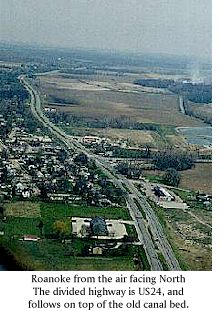  When John Stopher was about one year old his family moved to Roanoke. In an
interview, he made the following remarks: "At that time the Old Wabash & Erie
Canal was being dug and the locks were then in the process of construction. The one at
Roanoke was called Dickey's lock. From that place to Fort Wayne, a distance of 16 miles,
was called the Sixteen mile Level and was the longest level on the entire canal. This was
also called the Summit Level. The lock at Fort Wayne was called East Lock and was near the
end of what is now Walton Ave. (now Anthony Blvd.). A feeder emptied near this place;
another feeder situated where Robinson Park used to stand emptied into the canal in the
West end of Fort Wayne. From the outlet of this feeder the water ran both ways; thus it
was called the Summit Level. When John Stopher was about one year old his family moved to Roanoke. In an
interview, he made the following remarks: "At that time the Old Wabash & Erie
Canal was being dug and the locks were then in the process of construction. The one at
Roanoke was called Dickey's lock. From that place to Fort Wayne, a distance of 16 miles,
was called the Sixteen mile Level and was the longest level on the entire canal. This was
also called the Summit Level. The lock at Fort Wayne was called East Lock and was near the
end of what is now Walton Ave. (now Anthony Blvd.). A feeder emptied near this place;
another feeder situated where Robinson Park used to stand emptied into the canal in the
West end of Fort Wayne. From the outlet of this feeder the water ran both ways; thus it
was called the Summit Level.
.John Stopher: Canal
builder. Indiana Waterways. Oct. 1983

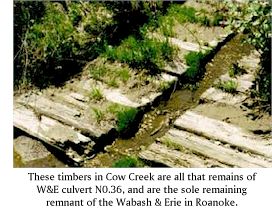  It was the winter of 1963 that D. Wayne Henricks spent much
of his time on a labor of love. From walnut, swamp elm and poplar timbers salvaged from
the Dicke lock of the historical Wabash and Erie canal, Henricks hand-crafted six inch
momentos in the shape of canal boat steering oars. It was the winter of 1963 that D. Wayne Henricks spent much
of his time on a labor of love. From walnut, swamp elm and poplar timbers salvaged from
the Dicke lock of the historical Wabash and Erie canal, Henricks hand-crafted six inch
momentos in the shape of canal boat steering oars.

Henricks fashioned 1,000, and intended to make another 1,000, but according
to his wife Mildred, he didn't get the second set done. Six of the canal momentos were
framed in shadow boxes also made from timber from Dicke lock. Of the six shadow boxes,
Mildred can account for the whereabouts of two. One is in her possession, and the other
was taken to Washington.

 In the first place, the
timbers might still be hidden in the hazy historical past had it not been for Indiana
& Michigan Electric Company. As Mrs. Henricks relates it, "I&M was digging
with scoops and came across this wooden structure. Everyone in Roanoke was excited. They
called me - I'm a history nut - because they thought I might know what it was, and I said
they'd hit Dicke lock. I&M was just pulling the timbers out and burning them."
"With the discovery the timbers weren't just any old pieces of wood, some of the
townspeople, the Henricks included, put in for a share of them. The town Marshall"
Mrs. Henricks said, "helped us load up some of the logs, and we took them to the
sawmill." In the first place, the
timbers might still be hidden in the hazy historical past had it not been for Indiana
& Michigan Electric Company. As Mrs. Henricks relates it, "I&M was digging
with scoops and came across this wooden structure. Everyone in Roanoke was excited. They
called me - I'm a history nut - because they thought I might know what it was, and I said
they'd hit Dicke lock. I&M was just pulling the timbers out and burning them."
"With the discovery the timbers weren't just any old pieces of wood, some of the
townspeople, the Henricks included, put in for a share of them. The town Marshall"
Mrs. Henricks said, "helped us load up some of the logs, and we took them to the
sawmill."
Fort Wayne Journal Gazette July 6, 1971
|